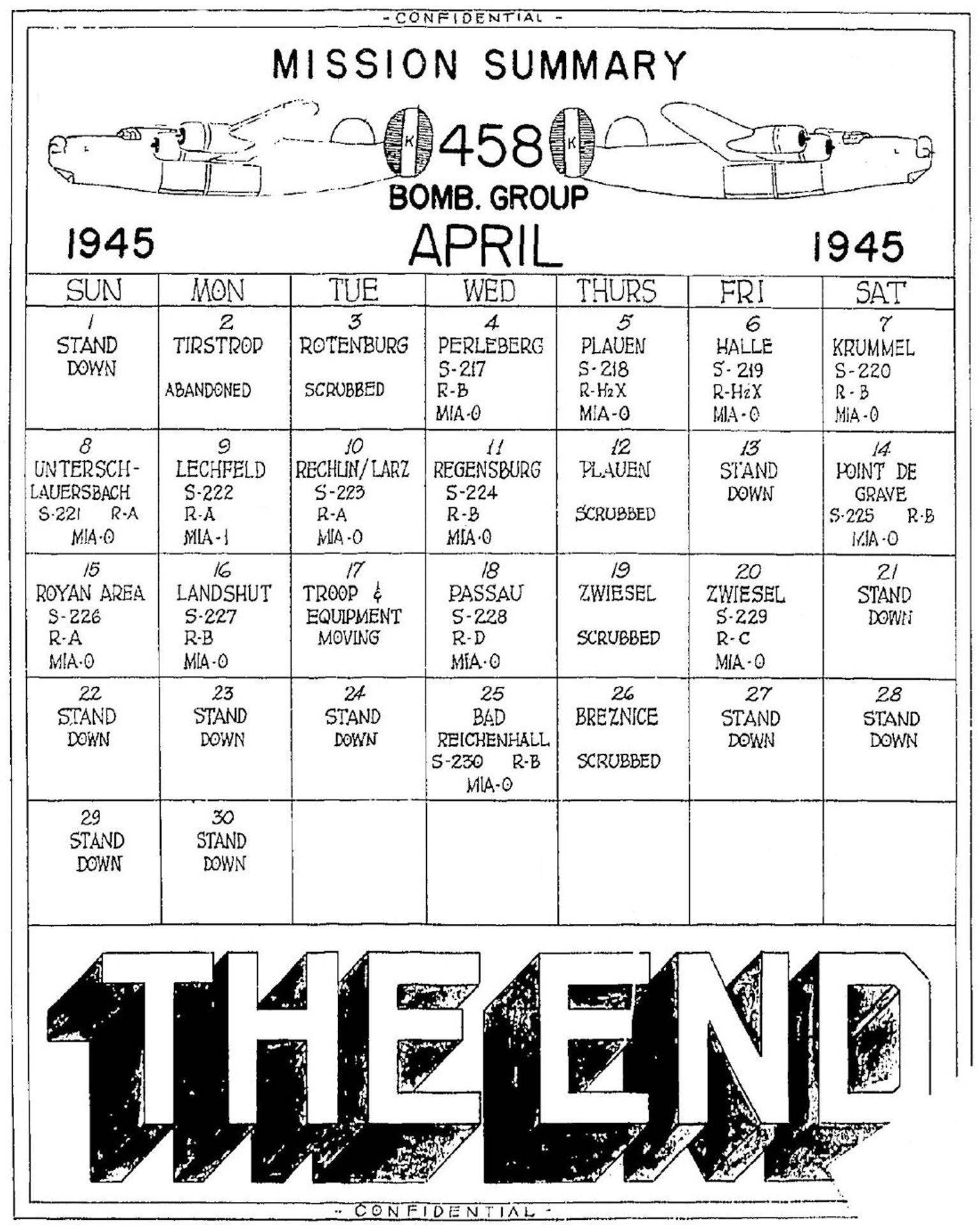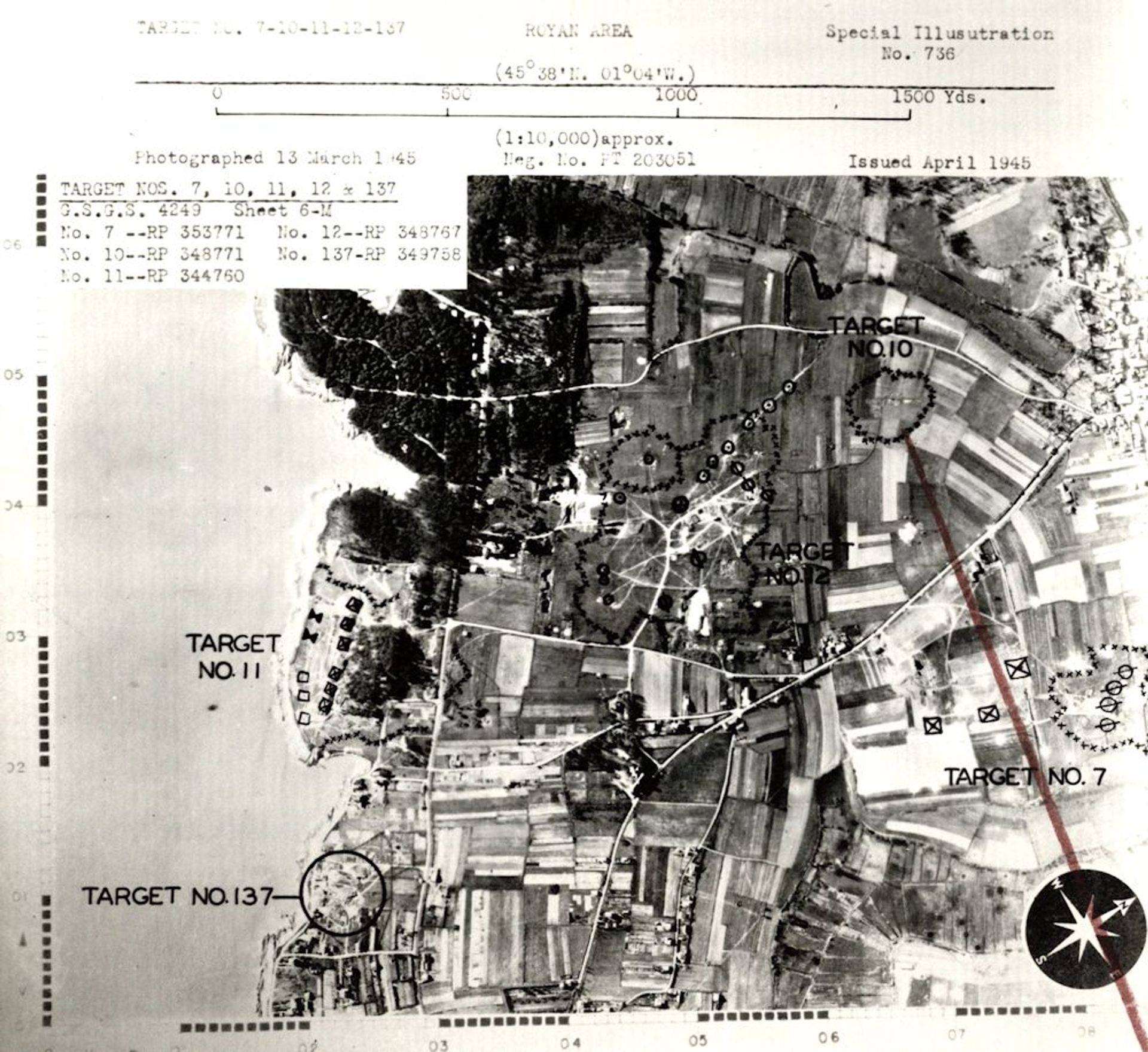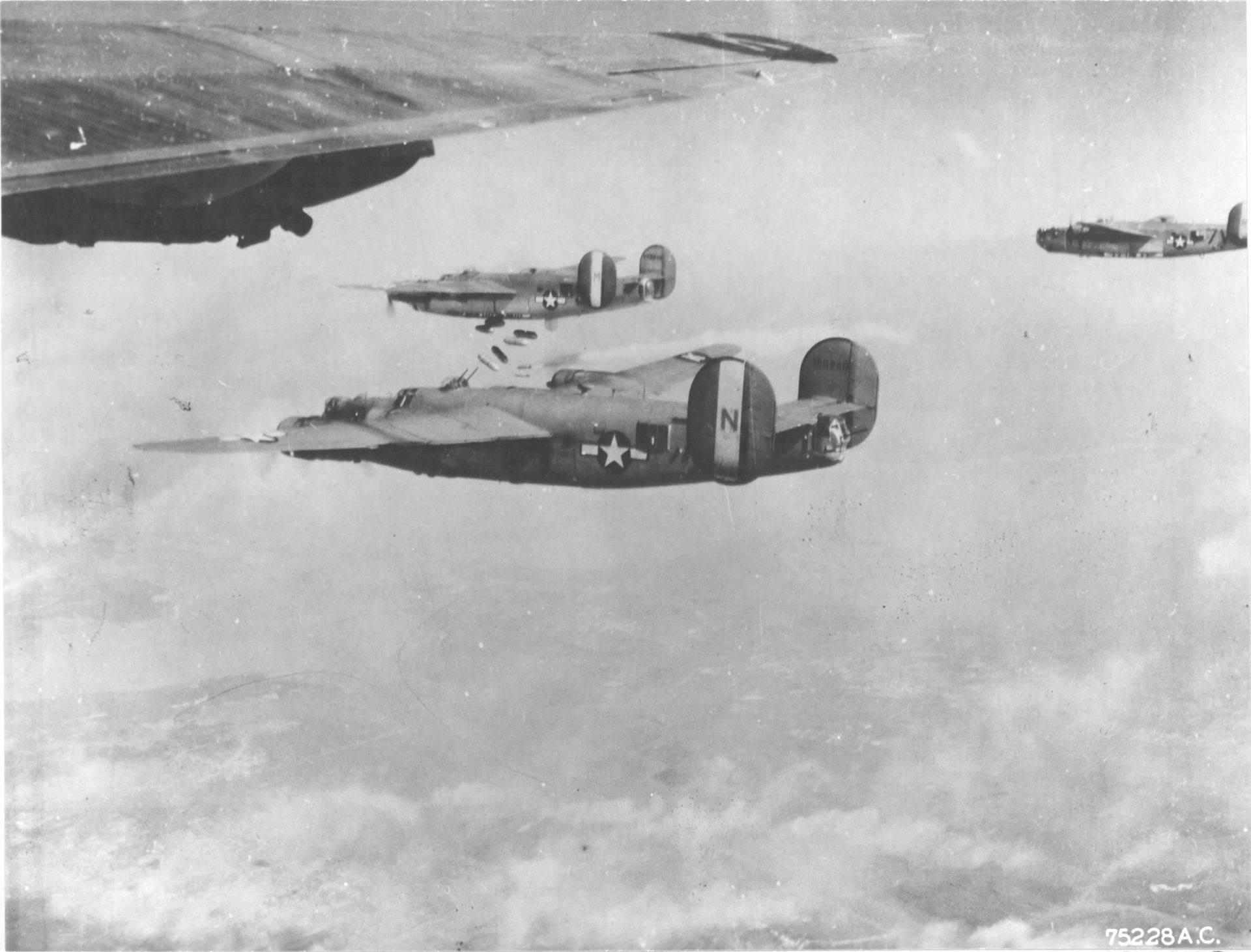458th Bombardment Group (H)
Mission Narrative
April 1945
458TH BOMBARDMENT GROUP (H)
HISTORY
SUMMARY OF OPERATIONS
This month saw the 458th Bomb Group ending its last combat mission in the ETO and it was with a feeling of pride to realize that our efforts while operational in this theatre greatly aided in bringing the Hun close to capitulation.
Speaking of efforts, let us look back on what we accomplished. We began operations on 2 March 1944 and ended up on 25 April 1945 with the following record: 240 combat missions, placing 5005 A/C over targets in enemy occupied Europe and Germany, dropping 13,168 tons of high explosives and incendiaries on vital industrial and military installations. The gunners of this group are credited with the destruction of 28 enemy A/C. In addition to this achievement, the group was responsible for transporting 727,160 gallons of gasoline to the Continent when it was so vitally needed for the ground forces.
The group has been cited by both the Eighth Air Force and the 2nd Air Division three times, twice on completion of our 100th and 200th missions, (incidentally, we flew 200 missions in less than a year’s operational time) and again when [on June 11, 1944] the group flew at the unheard of level for heavy bombardment of 6,500 feet, and despite heavy anti-aircraft fire, destroyed the vitally important railway bridge at BLOIS ST. DENIS, in FRANCE.
One large change in the organization of this station was the disbandment of certain subordinate units on the station which were then formed into the 377 [Air] Service Group. For full details on this change, refer to SO94, this headquarters, dated 15 April 1945 which is appended. We garnered 14 combat missions during the month and from here on we will discuss them in detail.
On 2 April the entire A/F sortied in three forces against six A/F’s [airfields] in DENMARK. We had, as our assignment, the A/F at TIRSTROP. However, due to adverse weather conditions in the target areas all forces abandoned operations. No sortie credit inasmuch as no bombs were dropped and no enemy action against the forces. It was clearly stated from higher headquarters that owing to the targets being in Denmark, that under no conditions would we bomb unless we had clear weather over the target area.
We chalked up our first mission of the month on the 4th when we attacked the A/F at PERLEBERG, 1-1/2 miles W of WITTENBERG and 80 miles SE of HAMBURG. Latest photo coverage showed at least 131 A/C on the field, mostly FW-190’s. We placed 37 A/C in the target area led by LT COL WILLIAMSON, CAPT BRECKENRIDGE and LTS MITCHELL and HOFFMAN. The lead squadron picked up the target visually and bombed. The other three squadrons did not see the target and did not bomb. The results of the first squadron’s bombs was excellent with SAV’s showing the MPI to be well covered with hits. Another A/F denied for the German’s use. An interesting note on this mission was the attack on the formation by one ME-262. We can’t remember back far enough to our last attack by E/A as we have been fortunate in not having been subjected to many E/A attacks in our operational period. The ME-262 made one pass and was fired on by several of our A/C, but broke off and disappeared. No claim was submitted. This brings us up to Mission 227.
Changing our plan of attack from A/F’s to M/Y’s, we were again airborne on the 5th, and having as our victim the M/Y at PLAUEN, our second priority target. This attack was in conjunction with [the] Eighth Air Force’s plan to neutralize all RR facilities in the general area where the Nazis were expected to make a last ditch stand. We had 25 A/C attacking, 24 of which attacked PLAUEN and one BAYREUTH. All bombing was done by H2X equipment with unobserved results. Total bombs dropped was a mixture of M-30’s, 500lb RDX’s and T-1’s, totaling 644 bombs. Lead honors go to MAJ WOODWARD, CAPT GARDNER and LTS DAHM and POLLIARD. The entire task force experienced extremely poor weather over on the Continent rendering many A/C non effective and causing difficulties in assembly and formations. We were rather proud of our boys this day for carrying on as some entire wings had turned back due to the adverse weather conditions.
Another M/Y was chosen as our assignment on the 6th when we attacked the M/Y at HALLE just north of MERSEBERG. This M/Y is a vital link between the north and south of Germany and in the area where the Hun was expecting to make his last ditch stand. LT COL O’NEILL, CAPT GOODFRIEND and LT JOHNSON led our formation of 26 A/C over the target, dropping 236×500 RDX bombs [using] H2X equipment with unobserved results due to 10/10th cloud coverage. Mission 229 went up on the scoreboard and we were all wondering how many more we would do.
Still on an unbroken streak of flying, we were again busy on the 7th placing a large formation of 38 A/C on an attack on a large explosive plant at KRUMMEL, a large installation that had become important due to [the] advance of Allied troops on both the Eastern and Western fronts. With the rapid advance of the Allies, the products of this plant were going directly to artillery and A/A units instead of to ordinance depots, and it was therefore extremely important that it be eliminated. Leading the four squadrons was MAJ HENSLER and LT’S WILLIAMS, HELFRECHT, and MITCHELL. We had good weather over the target and all bombing was visual and our mission narrative report states: 29 A/C attacked KRUMMEL visually, results: good. 8 A/C attacked NEUMUNSTER M/Y visually, results: very good. A total of 385×500 GP’s left the bomb bays of our A/C and Mission 230 was duly noted on our records.
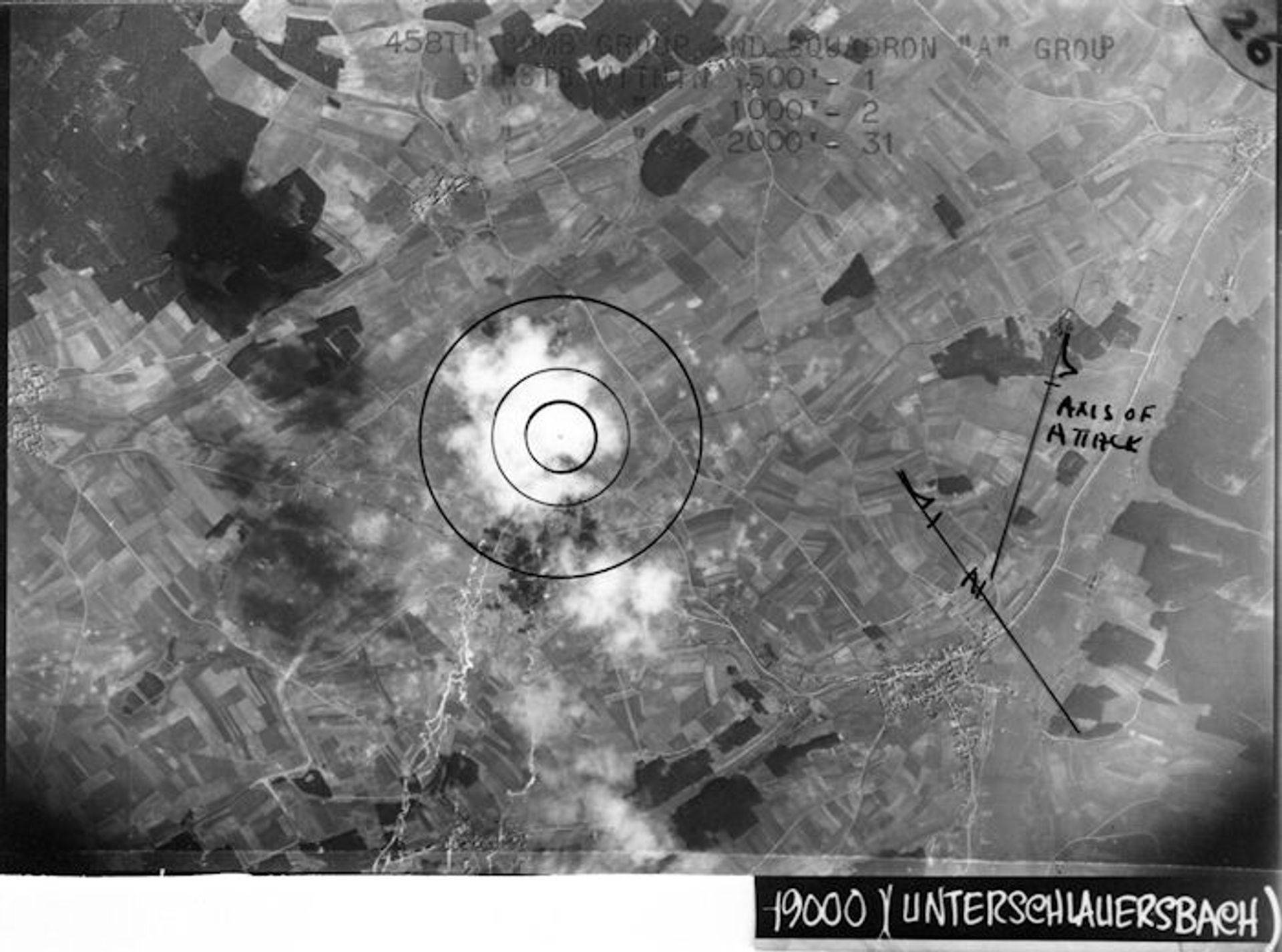
The name of our target on the 8th is really a killer, but after [the] excellent results of our attack, we don’t think the name will be used again. Hold onto your hats and take a deep breath and say, “UNTERSCHLAUERSBACH” without sneezing. All kidding aside, the group is proud of the job done. Our target was the A/F at “you know where”, and was high priority as the Hun was relying heavily on this field in their jet operation both as a training and refitting base. The honors of leadership go to MAJ BREEDING, CAPT BRECKENRIDGE and LT LANQUIST. Twenty-eight of our A/C attacked the target dropping 504×250 GP’s with the following results: attacked by visual methods – photo coverage revealed excellent results by two squadrons, and the third hitting about 1500 feet short and south of assigned MPI. Another excellent job accomplished.
On the 9th we paid a visit to our old friend LECHFELD A/F which we had attacked way back in March 1944. The field was an important jet repair and equipment center, training and testing field. Our leaders, MAJOR RUE, CAPT GARDNER, and LT’S JOHNSON and LANQUIST enjoyed a visual mission, leading 35 A/C over the target, dropping 384×100 GP’s, 146×250 GP’s and 322×260 GP’s with the following results: 18 A/C of first two squadrons obtained excellent hits on MPI as shown by SAV’s. 17 A/C of second two squadrons had very poor results, SAV’s showing their hits to be 4,000 to 6,000 feet from MPI. [This narrative fails to mention the loss of the last Liberator that the group would suffer in the war. FINAL APPROACH was shot down over the target with Lt Leonard Abramowitz as pilot. Another A/C flown by Lt Robert W Burman was forced down on the Continent with the two waist gunners KIA. These losses are listed in the MIA/KIA section.]
Without letup since the 4th of the month, we were again airborne on the 10th with an attack on the RECHLIN/LARZ A/F, another jet field which was on the program to be eliminated. On this mission we again enjoyed good visual conditions and under the excellent leadership of MAJ HENSLER and LT’S McCARTNEY and MITCHELL we chalked up Mission 233 as a bang up job, as our mission narrative relates: twenty-nine A/C attacked RECHLIN/LARZ A/F by visual methods. Crews report good results. SAV indicates good to excellent results.
Up again on the 11th with 27 A/C under the leadership of COL HERZBERG, CAPT BRECKENRIDGE and LT ANDERSON attacking the OIL REFINERY at REGENSBURG, dropping 88×1000 GP’s and 530 M-17’s on the target with the following results: good hits in target area, some part of pattern 500 feet over and to the right of MPI with some bursts trailing into MPI. Photo coverage taken later showed results of the 2nd Air Division to be very good. Huge explosions were seen in the area and one M47 bomb hit an oil tank and set it afire. We feel sure we are on the home stretch as it seems to us that we have bombed about everything that was standing in Germany before this big fracas.
A mission of a different sort fell our lot on the 14th. The extremely important target of POINTE DE GRAVE at the mouth of the GIRONDE ESTUARY in FRANCE which had been occupied by the Nazis and by-passed by the Allies, was to be attacked by the entire Eighth Air Force in coordination with the French ground forces who would move in as soon as this area had been bombed.
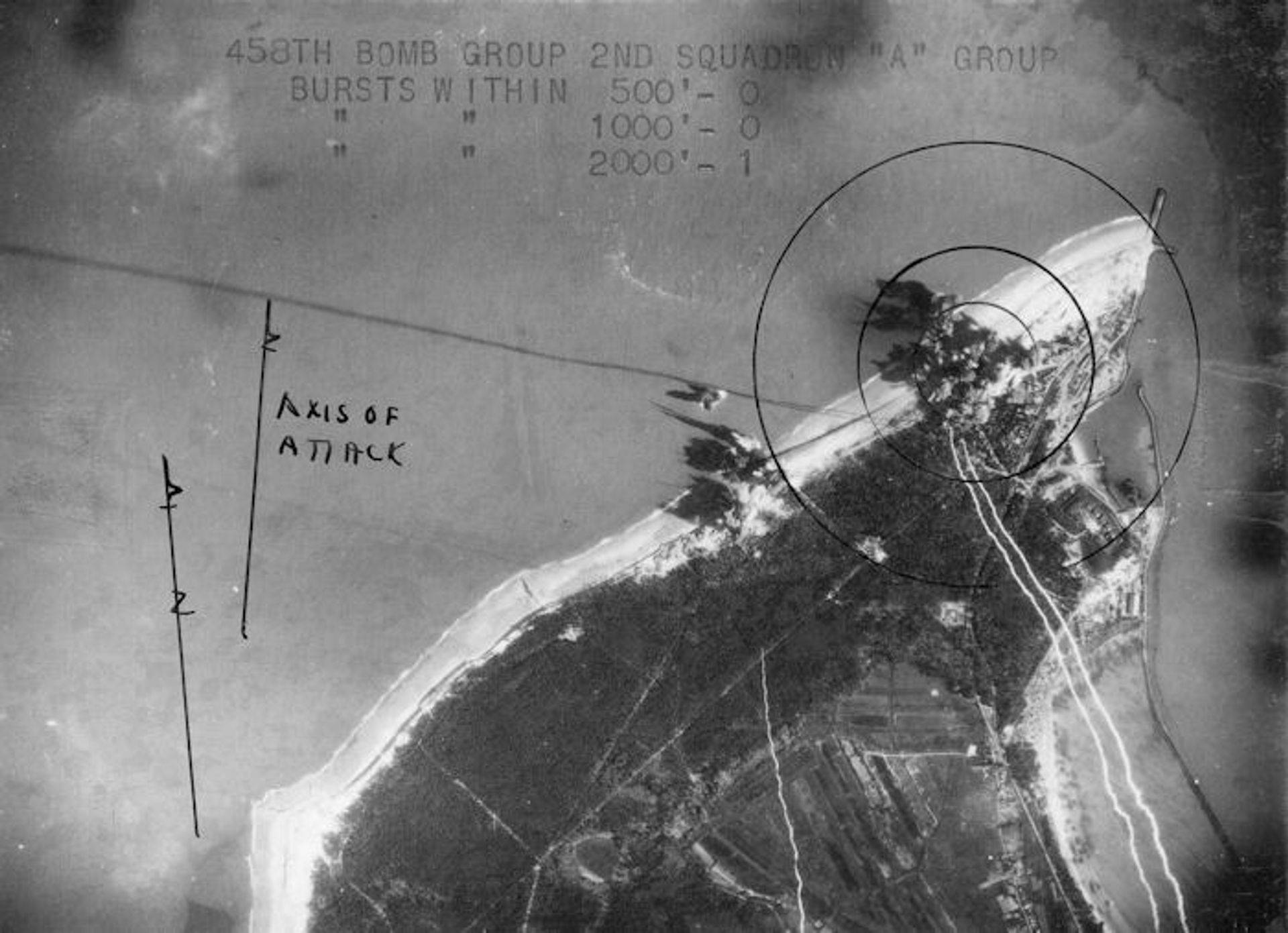

SAV from April 14, 1945 – The 1st and 2nd Squadron’s results are on the left; the 4th Squadron is on the right.
In order to illustrate the importance of eliminating this pocket, we quote from 2AD Intelligence Annex #1 to Field Order 657: “It is estimated that there are 122,000 Nazis in the area under attack by the 2AD and 3AD tomorrow. The region is very well defended. The ground defenses are heavy, including anti-tank ditches, barb wire, trenches, pill boxes and other emplacements. The Nazi soldiers in these isolated places have spent most of their time in such construction. There are many heavy gun positions, well manned and well supplied with ammunition, as is evidenced by the number of Allied A/C damaged when flying over the area. These garrisons have been supplied by submarines, coastal craft, and air transport. In many months these methods have not functioned so well. As a result, the Nazis have made frequent raids on nearby civilian areas, driving off cattle and other animals.”
LT COL HOGG was the Command Pilot leading the Group on this mission, placing 26 A/C over the targets, dropping 86×2000 GP’s with the following results: 26 A/C attacked targets No. 17 & 38, POINTE DE GRAVE visually. SAV shows first and third squadron results: excellent, second squadron: fair, and fourth squadron: fair to poor.
We quote a letter from General Jacob L. Devers, Commanding General of the Sixth Army Group, which was forwarded to General Doolittle and in return, down to the Groups participating in this mission.
Quote “General De Larminat, [right] commanding the Army Detachment of the Atlantic, wishes me to express his sincere gratitude for the cooperation you and the members of your command exhibited in the planning and execution of OPERATION VENERABLE. The weight and accuracy of the bombing effort on the heavily fortified areas of Royan and Point De Grave achieved excellent results and made it possible to open the Gironde Estuary with the minimum of casualties to our ground forces. Your forces showed a high sense of combat efficiency and camaraderie in the accomplishment of a job well done.” Unquote
Receiving such a splendid commendation made every man in the organization feel proud to be in a unit of the greatest Air Force in the world. [On this date, the group lost two B-24’s on takeoff. The 752nd Squadron crew of Lt Rex M Gibson and Lt David R Totten from the 754th Squadron crashed in the dense fog. Losses are listed in MIA/KIA section]

April 15, 1945 – Royan – Target Information file and 458th formation releasing Napalm canisters.
Many of us had heard of the new jellied gasoline bombs called Napalm, but heretofore we had never used Napalm and it was with great interest to hear that in another raid to the ROYAN AREA, the 458th would be using 75 and 85 gallon tanks of Napalm. Word was also passed around that we would also use a number of planes carrying M-47 incendiaries. The Napalm would be dropped first, then the incendiaries would follow. After our successful bombing of the previous day, we were assigned another target in this area to make devastation so complete that the French forces could move in and mop up the remaining Nazis left. MAJOR LAVELL, Asst S3, was the Command Pilot for the day, leading 27 A/C over the target area, dropping 45×75 gallon tanks and 85-gallon tanks, plus 156 M-47’s in the target area with unobserved results due to the heavy smoke from previous groups. However, the damage wrought this day made it possible for the French to capture the entire area with little personnel loss. It is interesting to note that there was no fighter escort furnished this day, we believe the first time in the history of the group.
After our successful attacks on the GIRONDE ESTUARY that paved the way for the entry of the French troops and the final clean-up of the German garrison, we were back on the job on the 16th with an attack on our third priority target, the M/Y at LANDSHUT, GERMANY. We garnered individual A/C sortie credit of 27, with the command lead going to MAJOR BREEDING. We had hoped for a visual run and the gods were with us. We dropped 258×500 GP’s with the following results: SAV’s show that two squadrons obtained very good hits on two visually selected MPI’s while the other squadron had poor results. Sortie 237 was posted on the books.
It fell our lot on the 18th to again attack another M/Y, namely the M/Y at PASSAU, our second priority target. Of the 28 A/C dispatched under the leadership of LT COL WILLIAMSON, not one aborted and a total of 120×1000 GP’s was dropped on the target visually with two squadron’s results being poor due to a mechanical malfunction, and the third squadron racking up good results. These malfunctions will happen and it’s all part of the battle of chess, but the results of the third squadron’s bombings compensated for our trip.
Coming down the home stretch we found ourselves again airborne on the 20th, attacking an important RR BRIDGE at ZWIESEL on direct request from the ground forces. The twenty-nine A/C attacking did a bang up job under the lead of MAJ HENSLER, as our mission narrative reads: 20 A/C attacked ZWIESEL, visually. Crews report results good. SAV’s show major part of pattern around junction of three rail lines. 9 A/C attacked rail lines 3 miles north of EISENSTEIN, visually. SAV’s show hits on RR tracks and highway. It is interesting to note that not one malfunction occurred in bombing and that the total load of 133×1000 GP’s loaded left the bomb bays of this group’s A/C and all hit the targets.
And now we come to the last mission the group would participate in as a member of one of the greatest air forces the world has ever seen. While this history is of April and final word to cease operations did not come through until May, we cannot but help mentioning this as our last mission as this history is being written up in May. Sort of beating the gun, but with the joy we feel in our hearts, we humbly apologize for our premature disclosure of the operational ending of the group in the ETO.
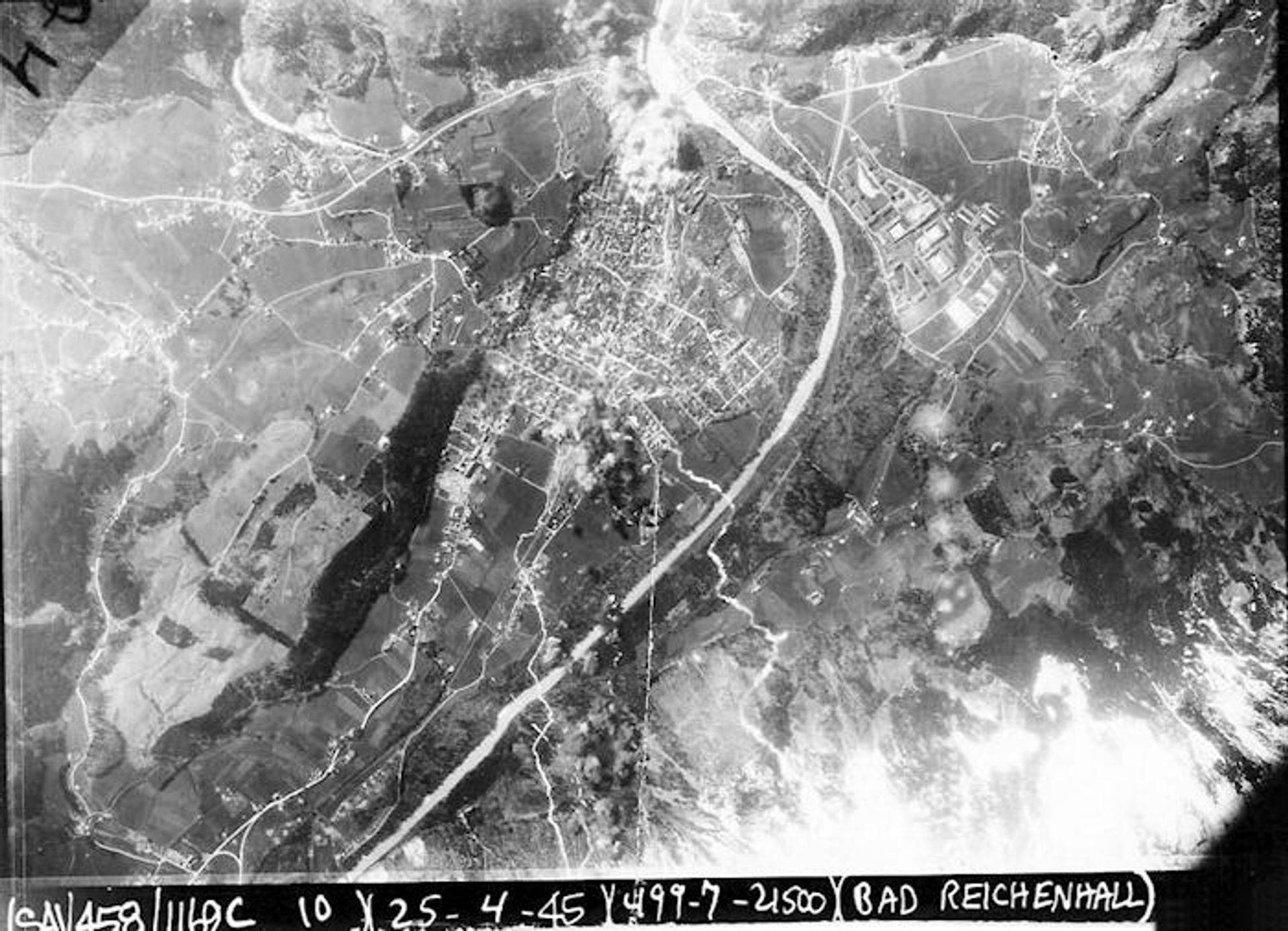
We will always remember our last mission, 25 April 1945. A historic date to be retained in our memories forever. Again the target attacked was on the request of SHAEF. The RR at BAD REICHENHALL in the SALZBURG AREA where the Nazis had been pushed and were making a last stand. As a fitting tribute to our last mission, no other than our commanding officer, COL HERZBERG led our formation. Our formation consisted of 3 nine-ship squadrons, and it is gratifying that on our last mission the bombing results were excellent. And so finishes our combat tour in the ETO. It has been a long hard road to travel, but the 458th more than justified its existence with its excellent record which will go down in history.
| SUMMARY | |
|---|---|
| Missions for Month | 14 |
| Missions to Date | 240 |
| A/C Attacking for Month | 378 |
| A/C Attacking to date | 5005 |
| Tons Dropped for Month | 897 |
| Tons Dropped to Date | 13,168 |
| Missing for Month | 1 |
©2023 458bg.com | All Rights Reserved | Privacy Policy | Designed by HL Media LLC

